Maple Sugaring, an Even Earlier Spring in the Northern Woods, or Sugaring Off 2006 pt. 2
Now, the trick with finding a cabane à sucre in the spring is not unlike the trick involved in finding an a "U-pick" apple orchard in the fall. You want a place that's got good maple syrup, of course, but in this region it'd be pretty hard to find a place with poor product; you don't want a place with lots of bells and whistles (you don't want it to feel like a Ronald McDonald Playland or something); and, fundamentally, you want a place that actually serves good food at a decent price, 'cause god knows there are dozens and dozens of places that are playing on people's nostalgia for yesteryear just so they can laugh all the way to the bank. It's really hard to find a maple farm that still uses the traditional pails to collect the maple sap, instead of the complex networks of plastic tubing that have become commonplace as the industry has become rationalized more and more, and that's had a detrimental effect on the look of most maple farms, not to mention the post-meal walks throught the woods that used to be customary, but you can still find plenty of places that are friendly, honest, and not super-sized and that still serve a nice, big multi-course sugar shack breakfast. We've always been fond of the Lanaudière region just to the northwest of the city--it might not be the most dramatically beautiful region of Quebec, but its back roads still get rather lovely and it's down-to-earth and friendly and not nearly as touristy as the Laurentians or the Eastern Townships--and we've had pretty good luck with finding cabanes à sucre there. We found a place we really liked near l'Éphiphanie a few years ago with our friend Caro, but this year we wanted to go someplace different and we got tipped off to another place we were told was a real classic (they've got 14 kids, after all) near St-Esprit: Cabane à Sucre Constantin Grégoire.
How to spot a good cabane à sucre in a few easy steps:
What's the atmosphere like? Is it a bit rustic, is it welcoming?
Test #2 has to do with the fixins that adorn the tables. Are they generous? Are they well-made? Do they at least have ketchup aux fruits and homemade pickles along with the mandatory house maple syrup?
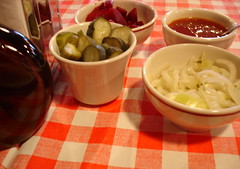
Sample the ketchup aux fruits. Is it everything you hoped for in a homemade ketchup? Now, most importantly, sample the maple syrup. Pour yourself a spoonful and savor it. Is it a fine maple syrup, well-rounded and rich in true maple flavor? And, finally, take a piece of bread/toast or a bun and slather it with the cretons. Are they savory and spicy just like Matante Simone [substitute the name of whichever relative of yours made the best cretons] used to make? Do they make you want to slather many more pieces of toast with them?
Your standard cabane à sucre breakfast will consist of a real barrage of dishes: a bowl of French Canadian-style pea soup (usually made with whole yellow peas), eggs prepared simply (scrambled, for instance), baked beans, bacon and/or sausages and/or jambon toupie cooked in maple syrup, oreilles de Christ (the infamous fried pork rinds side dish), crêpes (which are generally made the old-fashioned way, which resembles a cross between a crêpe and a beignet), and finally tarte au sucre. There are all kinds of variations of this menu, but these are the essentials. The cabanes à sucres that I like the best not only serve a high-quality spread, they also have a low-key approach to serving, giving you plenty of time to relax and enjoy your meal and not putting any ridiculous pressure to overeat on you (beyond the lure of the various temptations served).
The folks at Constantin Grégoire scored high marks in all of the above categories, my favorites dishes being the baked beans, the ketchup maison, and the ham, and Fred, our server, was a true country gentleman.
Having eaten our fill, it was time to move outside, duck under the roof to shield ourselves from the highly unpicturesque early spring downpour we were getting, and have ourselves our first tire d'érable of the season. They had long flats outside filled with snow ready and waiting for customers to stumble out and get one last powerful maple sugar jolt (keep in mind we'd had maple syrup in one form or another with nearly ever dish we'd eaten inside, according to the custom) before wandering the grounds or hitting the road. The tire master showed up with a fresh batch of the hot maple syrup concoction soon after we stepped outside and he promptly began pouring the liquid onto the snow.
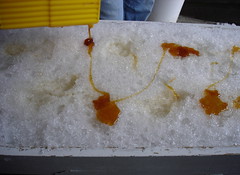
We then took our popsicle sticks, waited for a few seconds for the syrup to start to freeze a little, then used the stick to roll up our maple syrup taffy.
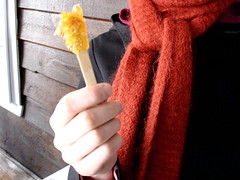
Makes you feel like a kid again every time.
All in all, we really enjoyed ourselves, but it was hard not to fixate on how uncharacteristic the weather we were having was, how out of step the heavy rain, the muddy cabane à sucre terrain, and the utter lack of snow was with traditional representations of sugaring off season. I mean, just look at the imagery that's used to package Quebec maple syrup:
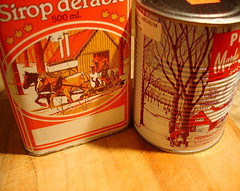
And just look at the reality ca. 2006:

Made me think of that massive body of paintings, prints and other images that we're all still so familiar with that represent winter in Holland with vignettes of skating on Dutch canals, sleigh rides, etc. and how these days, every once in a while, when Holland gets a winter that actually freezes its canals for any length of time it's news.
Even the horses at Cabane à Sucre Constantin Grégoire looked a little depressed:
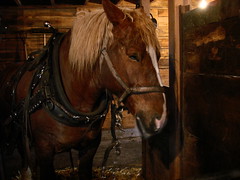
All they wanted to do was get out in the snow and pull that big old sleigh around, but no.
Good thing we had that maple sugar buzz going. Took us hours to come down, and by the time we got back to Montreal it was sunny and beautiful and we'd forgotten all about what early spring in Quebec is supposed to look like.
aj









No comments:
Post a Comment